Authentic Cisco 100-105 exam dumps is the best way to prepare for Cisco 100-105 ICND1 exam
What is the best way to prepare for Cisco 100-105 ICND1 exam? 1. Buy the official Cisco study guide and learn at least 2 to 3 hours a day. 2. Buy practical exams from a well-known Pass4itsure supplier. (https://www.pass4itsure.com/100-105.html 100-105 dumps Q&As: 773) 3.Have hands-on practice for answering simulation type questions.4.Preparation usually takes 2 to 3 months. Once you feel confident, take the actual exam.
Cisco 100-105 ICND1 Exam Study Tips And Information
Exam By:Cisco
Exam Code:100−105
ExamName:Interconnecting Cisco Networking Devices Part 1 (ICND1)
Related Certification(s):CCENT, CCNA Routing and Switching, CCDA, CCNA Security, CCNA Wireless
See details https://www.cisco.com/c/en/us/training-events/training-certifications/exams/current-list/100-105-icnd1.html
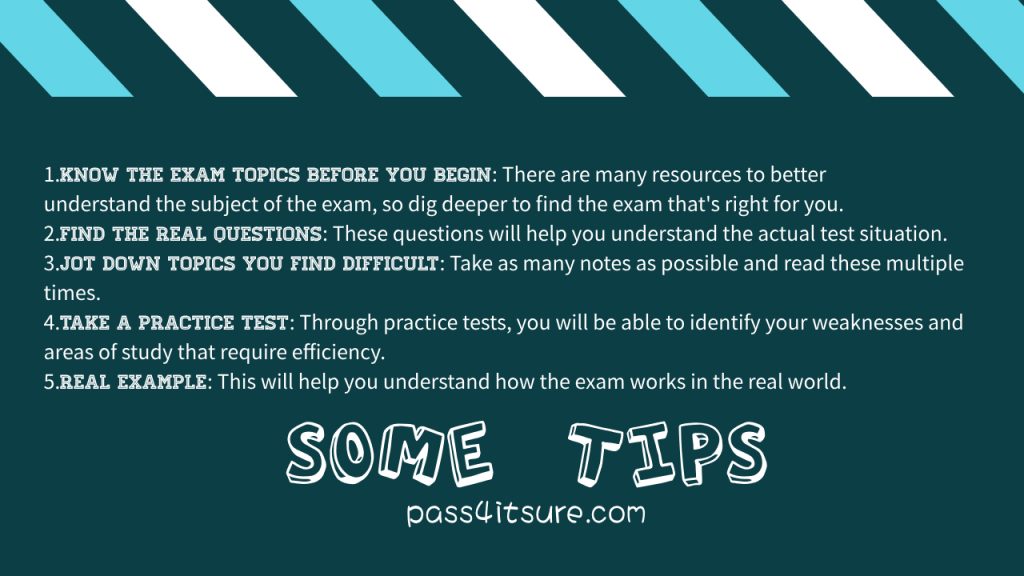
The Cisco 100-105 exam symbolizes beginner-level certification that focuses on leveraging Cisco technology innovation and building a foundation on a network basis. The Cisco 100-105 certification is for individuals who want to use the Cisco 100-105 exam to build a strong and stable career in the networking space.Pass4itsure helps its Cisco 100-105 exam customers with authentic and quality study content.
The Cisco 100-105 exam certification benefits:
- Greatly improved the professional reliability of the owner
- Individuals who have taken the Cisco 100-105 certification exam have a better advantage in holding fixed positions in IT companies
Get the latest | From Google Drive Cisco 100-105 PDF Dumps Download
(Free) Cisco 100-105 PDF Dumps
https://drive.google.com/open?id=1BAVxCEMj0ptWF7YTlJlMIZ8UAImCQK1p
https://drive.google.com/open?id=1Cgj562QGGGi5hbdaCjZZFmAWhrDyIJ9u
Try latest Cisco 100-105 Exam Dumps Actual Questions(1-13)
QUESTION 1
Which two statements describe the operation of the CSMA/CD access method? (Choose two.)
A. After a collision, all stations run a random backoff algorithm. When the backoff delay period has expired, all stations
have equal priority to transmit data.
B. In a CSMA/CD collision domain, multiple stations can successfully transmit data simultaneously.
C. After a collision, the station that detected the collision has first priority to resend the lost data.
D. The use of hubs to enlarge the size of collision domain is one way to improve the operation of the CSMA/CD access
method.
E. After a collision, all stations involved run an identical backoff algorithm and then synchronize with each other prior to
transmitting data.
F. In a CSMA/CD collision domain, stations must wait until media is not in use before transmitting.
Correct Answer: AF
Ethernet networking uses Carrier Sense Multiple Access with Collision Detect (CSMA/CD), a protocol that helps devices
share the bandwidth evenly without having two devices transmit at the same time on the network medium. CSMA/CD
was created to overcome the problem of those collisions that occur when packets are transmitted simultaneously from
different nodes. And trust me, good collision management is crucial, because when a node transmits in a CSMA/CD
network, all the other nodes on the network receive and examine that transmission. Only bridges and routers can
effectively prevent a transmission from propagating throughout the entire network! So, how does the CSMA/CD protocol
work? Like this: when a host wants to transmit over the network, it first checks for the presence of a digital signal on the
wire. If all is clear (no other host is transmitting), the host will then proceed with its transmission. But it doesn\\’t stop
there. The transmitting host constantly monitors the wire to make sure no other hosts begin transmitting. If the host
detects another signal on the wire, it sends out an extended jam signal that causes all nodes on the segment to stop
sending data (think, busy signal). The nodes respond to that jam signal by waiting a while before attempting to transmit
again. Backoff algorithms determine when the colliding stations can retransmit. If collisions keep occurring after 15 tries,
the nodes attempting to transmit will then time out.
QUESTION 2
Which one of the following IP addresses is the last valid host in the subnet using mask 255.255.255.224?
A. 192.168.2.63
B. 192.168.2.62
C. 192.168.2.61
D. 192.168.2.60
E. 192.168.2.32
Correct Answer: B
With the 224 there are 8 networks with increments of 32 One of these is 32 33 62 63 where 63 is broadcast so 62 is last
valid host out of given choices.
QUESTION 3
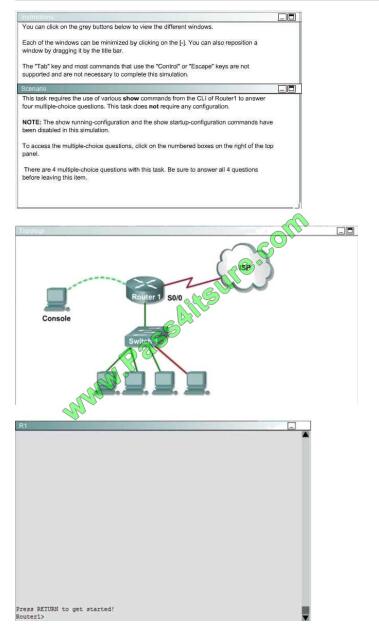
What interfaces on Router1 have not had any configurations applied? (Choose two.)
A. Ethernet 0
B. FastEthernet 0/0
C. FastEthernet 0/1
D. Serial 0
E. Serial 0/0
F. Serial 0/1
Correct Answer: BF
User the “show ip interface brief” command
Notice that Router1 does not have Ethernet 0 and Serial 0 interfaces. FastEthernet 0/1 and Serial 0/0 were configured
with their IP addresses therefore only FastEthernet 0/0 and Serial0/1 have not had any configurations applied.
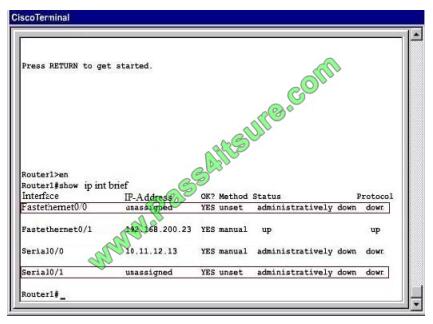
QUESTION 4
Which value represents a host route?
A. 192.168.1.0/30
B. 192.168.1.0/24
C. 192.168.1.2/31
D. 192.168.1.0/32
Correct Answer: D
QUESTION 5
A receiving host has failed to receive all of the segments that it should acknowledge. What can the host do to improve
the reliability of this communication session?
A. decrease the window size
B. use a different source port for the session
C. decrease the sequence number
D. obtain a new IP address from the DHCP server
E. start a new session using UDP
Correct Answer: A
QUESTION 6
You recently applied a common configuration to several PCs on different VLANs. The PCs are connected to the same
switch with a router-on-a-stick, but users report that the PCs cannot ping one another. Which two are possible reasons
for the problem? (Choose two.)
A. The access ports on the PCs are misconfigured.
B. The native VLAN on the router is misconfigured.
C. The ip default-network command is misconfigured on the router.
D. The trunking protocol is configured incorrectly on the router subinterfaces.
E. The VLAN is configured incorrectly on the router subinterfaces.
Correct Answer: AE
QUESTION 7
Refer to the exhibit.
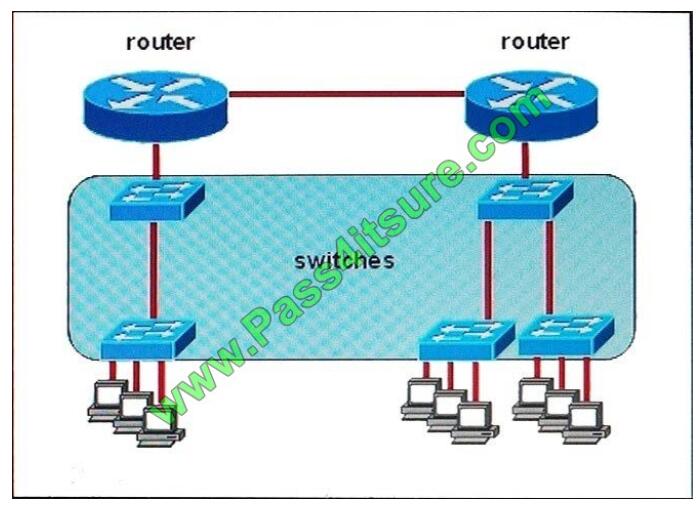
All devices attached to the network are shown. Which number of collision domains are present in this network?
A. 9
B. 3
C. 6
D. 2
E. 15
Correct Answer: E
A switch uses a separate collision domain for each port so there are a total of 9 for each device shown. In addition to
this, the switch to switch connections (3) are a separate collision domain. Finally, we add the switch to router
connections
(2) and the router to router connection (1) for a total of 15.
QUESTION 8
What is the requirement of configuring 6to4 tunnelling on two routers?
A. Both ipv6 and ipv4 must be configured
B. Only IPv6
C. Only IPv4
Correct Answer: A
QUESTION 9
You have configured two hosts that are connected to a single switch, but reside in different VLANs. Which statement
about the configuration is true?
A. The two hosts are unable to communicate without a router.
B. The two hosts can communicate with ICMP.
C. The two hosts are unable to communicate without a trunk port.
D. The two hosts are unable to communicate without a hub.
Correct Answer: A
QUESTION 10
Two routers named Atlanta and Brevard are connected by their serial interfaces as shown in the exhibit, but there is no
data connectivity between them. The Atlanta router is known to have a correct configuration.
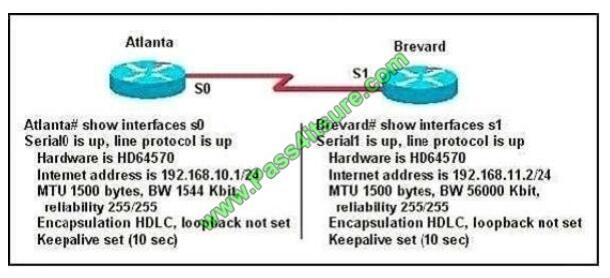
Given the partial configurations shown in the exhibit, what is the problem on the Brevard router that is causing the lack
of connectivity?
A. A loopback is not set.
B. The IP address is incorrect.
C. The subnet mask is incorrect.
D. The serial line encapsulations are incompatible.
E. The maximum transmission unit (MTU) size is too large.
F. The bandwidth setting is incompatible with the connected interface.
Correct Answer: B
QUESTION 11
In which two scenarios do you implement private IPv4 IP addresses? (Choose two.)
A. on the webmail portal of an organization
B. on the connection that a mobile device uses for application updates
C. to connect network equipment between different IDFs
D. for the VPN solution that end users use to connect to the local network
E. on an application server that connects to a local database server
Correct Answer: CE
QUESTION 12
After the network has converged, what type of messaging, if any, occurs between R3 and R4?
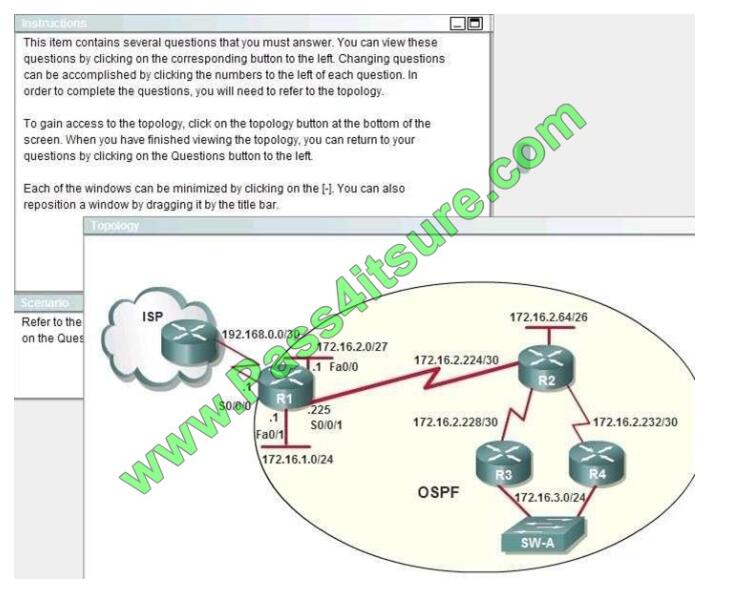
A. No messages are exchanged
B. Hellos are sent every 10 seconds.
C. The full database from each router is sent every 30 seconds.
D. The routing table from each router is sent every 60 seconds.
Correct Answer: B
HELLO messages are used to maintain adjacent neighbors so even when the network is converged, hellos are still
exchanged. On broadcast and point-to-point links, the default is 10 seconds, on NBMA the default is 30 seconds.
Although OSPF is a link-state protocol but the full database from each router is sent every 30 minutes (not seconds) ->
C and D are not correct.
QUESTION 13
Which NAT type is used to translate a single inside address to a single outside address?
A. dynamic NAT
B. NAT overload
C. PAT
D. static NAT
Correct Answer: D
Network address translation (NAT) is the process of modifying IP address information in IP packet headers while in
transit across a traffic routing device.
There are two different types of NAT:
NAT
PAT
Static NAT is used to statically map a single IP address on the inside to a single outside IP address.
Best discount code sharing(Pass4itsure)

Summarize:
Guaranteed Success After Getting Cisco 100-105 exam questions by Pass4itsure(https://www.pass4itsure.com/100-105.html )!